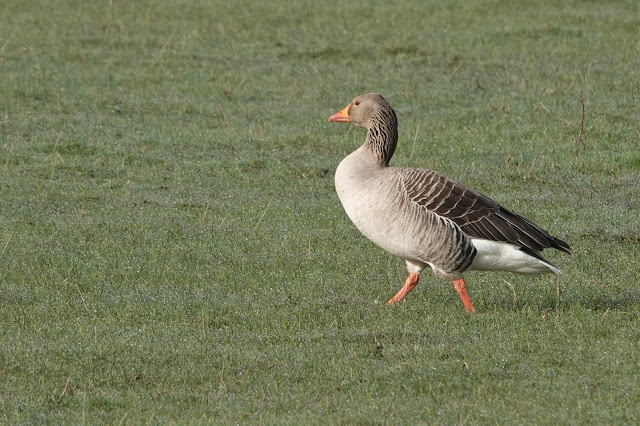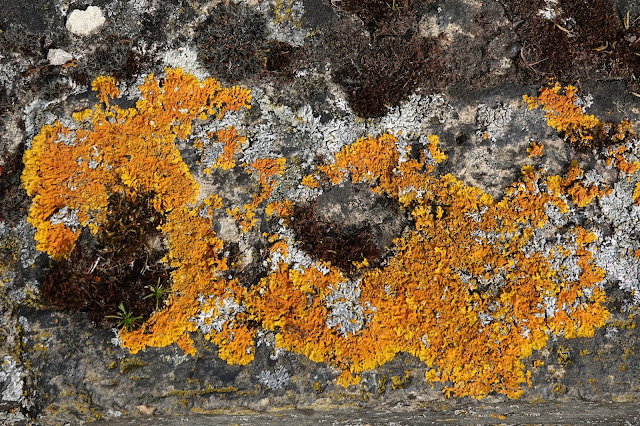I was quite taken with Higham Marshes on my Monday walk and
so headed back there at about eight this morning for a different approach. This
time I parked by St Mary’s Church (where I had lunch) and struck out on a
reverse route. I had only just got past
the church when my brain said ‘Cuckoo’. In any other year it would have discounted
it but there were two fairly local yesterday so I stopped and it sang again! Remarkable!
It was off somewhere in that very wet woodland that I would be sensibly
avoiding this time. A couple of
Blackcaps and Chiffchaffs were bringing in the day and a Willow Warbler joined
in from the hedge as I sloshed across the field to the first style.

The cattle were still in their misty field and after
admiring the fine Bull amongst the heifers I had another go at Cattle Egret
hunting. Almost immediately I found an Egret and the head wobble told me I had
scored but it walked behind some prime beef and a few minutes later reappeared
as a Little Egret. I was puzzled but stuck with it and sure enough the Cattle
Egret soon followed. Both were using the
cows but even at range their different hunting methods were apparent. The bill
on the Cattle Egret was only slightly orange and I suspect that it had mud on
it rather than being in breeding colours as there was not a spot of buff on the
head or mantle.
 |
'Wouldn't want to be in there with him' I thought
|
 |
A brace of Egrets
|
With no wind today the air was full of Skylark song and the
noisy Black-headed and Med Gull flock way out on the marsh could clearly be
heard.
 |
| Greylag |
A Sedge Warbler chattered away as I made my way through the
bushes and a pair of Long-tailed Tits moved ahead of me. I counted six visible Lapwing nests out on
the fields and was really hoping for some different waders so I was pleased to
find a Spotted Redshank that was just starting to moult and a male Ruff with a
gleaming white head. The Little Ringed
Plovers were heard but again I could not see them.
 |
| Oystercatcher |
 |
Spotted Redshank
|
The ewes and lambs were enjoying the watery sunshine and many
seemed to have triplets and there was at least one with quads. A Water Shrew was noisily fossicking in the
ditch edge and a Water Rail was wheezily singing from another reedy channel.
With the increase in temperature there were many more
Andrena flavipes around and a couple of Small Whites amongst the Peacocks and
Small Torts. The duck were still in the
rills and a good scan did not reveal anything new but these pools are crying
out for Black-winged Stilts, Garganey and passage waders if the water lasts
into the late spring.
 |
Small White
|
 |
Shoveler and Teal
|
When I got to the seawall I crossed over the spur onto the path
to Cliffe Fort. The tide was completely
out and a man was walking the actual tideline in Wellies with a trowel in hand
but as a consequence he kept spooking the Avocets, Redshanks and Black-tailed
Godwits. There were about 150 of the
latter and most were in breeding finery as they stock up before the long
journey back to Iceland. A flock of
Dunlin were also seen along with Curlews and Oystercatchers.
 |
| Redshanks |
 |
| Black-tailed Godwits |
 |
Black-tailed Godwits and Coalhouse Fort
|
Cliffe Fort is actually properly moated and flooded and in a
sorry state of repairs unlike its sister Coldharbour Fort across the Thames at East
Tilbury. I sat for a coffee and envisaged
Black Redstarts flicking around or a Hoopoe probing in the sandy banks such is
the flights of fancy us birders take.
 |
Cliffe Fort
|
Three Cormorants were up on a big jetty and were joined by a
honking Egyptian Goose and his mate who had obviously taken possession of the
whole thing for the breeding season. I
think that they both went into the old workmans hut...
 |
| Egyptian Goose |
 |
Shelduck - they were on the roof of the Fort
|
Two Sand Martins flicked through and Linnets were feeding in
the path in front of me but it was the insects on the flowering Alexanders that
distracted me. There were many bees but they
seemed to stop so rarely. Most of those
that did so seemed to be Andrena flavipes and I found several what I believe to
be Nomada fucata in close proximity while a fluffy orange Andrena with a white
face would appear to be a male A.nitida.
 |
| Andrena flavipes |
 |
| Andrena flavipes |
 |
| Andrena nitida |
 |
Nomada fucata
|
Yellow Dung Flies were everywhere and some of the fresh horse
pats were covered in lovely furry flies. Many of the big males had already acquired
mates and were jealously guarding them from interlopers. The males were also out hunting from the
Alexanders flowers and would occasionally dash out after a smaller fly. Both Eristalinus aeneus and sepulchralis were present too, although it took a while to look at eye hairs!
 |
Yellow Dung Flies
|
 |
| Yellow Dung Fly |
 |
not sure yet
|
 |
| Eristalinus sepulchralis |
 |
| Eristalinus sepulchralis |
 |
Eristalinus aeneus - have to take my word about the half hairy eyes
|
I was even lucky enough to once again find Gonia picea and
several more Eudasyphora cyanella as well a many Dark-edged Bee Flies.
Brimstones and Peacocks were numerous and Orange Tips will not be too long now
I think.
 |
| Alexanders |
 |
| Eudasyphora cyanella |
 |
| Peacock |
I got better views of Avocets and Redshanks on the creek
beyond the fort and the Privet thicket added a few more Hoverflies to the day
list.
 |
| Avocets |
 |
Black Barn beyond
|
 |
Redshanks and Avocets
|
 |
Med Gull
|
I stopped at the Flamingo Pool where two Ringed Plover were
the only addition before cutting through the pits. The gull colony was in full swing and the
sheer number of Med Gulls is amazing. Hundreds were present on the main islands
and they seem to have pushed the less aggressive Black-headed Gulls towards the
edges and onto the small islands around them.
They will always be my favourite gull so I sat and watched them while I
ate my lunch and surrounded myself with the sound of Medway Summer.
My lunch spot was also home to some tiny mining bees but
getting a picture was somewhat challenging but I gave it go. I have asked for help so you never know,
there may be an identity down the line.
 |
Unknown Bee
|
Other than a few half hearted Blackcaps there was little
other small bird life as I plodded back towards the car park and tried my best
not to get distracted too often but Bees on the Alexanders!
 |
Parasitic Wasp sp
|
 |
Dark-edged Bee Fly
|
 |
Dock Leatherbug
|
The walk of discovery took me up Salt Lane and then in towards
the gravel works before veering through West Court Farm where a small patch of
Comfry where a green Soldier Fly was seen and awaits identification as I thought
it was Chloromyia formosa but they should not be on the
wing till May.
 |
| Comfry |
 |
Chloromyia formosa ?
|
 |
Japanese Quince
|
The route took me through the farmyard
with its pack of well trained Intruder Alarm Guinea Fowl and then cut through a
paddock filled with ewes and their multitudinous lambs which were ridiculously
cute before heading out across yet more amazing flooded fields and pastures
alongside the railway that services the workings.
There were a few Coots and Little Egrets
dotted around but like so much of this hidden habitat around here, it has a
more continental feel to it. I just hope
that the waters last. I now had horses for company and then some young Sussex
cows before crossing the railway and finding myself in the field with the main
herd of seriously chunky cattle that held the Egrets earlier.
 |
More Med Gulls!
|
They ignored me and the Bull was still
holding position and let me pass with no trouble as I headed to the small
bridge in the far corner and the last stretch back to the car. Although the sun had never really got going
it was still showing 23c and the air was actually hot and sticky which felt
very odd for the last day in March.
 |
| ROOOMMMEEEOOOO! |
I headed for home and had a cuppa up
the garden and watched the insects come and go.
There were several Eristalis pertinax laying eggs in the pond and
pondlets by flicking eggs in flight at the surface and I was pleased to find a
freshly emerged Myathropa florea gleaming as it rested on a log.
 |
| Eristalis pertinax |
 |
| Eristalis pertinax |
 |
| Myathropa florea |
 |
Velvet Mite
|
Being so warm has meant that I have had
to water in recent days but this has also benefited the gazillions of Sycamore
seedlings that have taken the opportunity to germinate in the newly landscaped
top third of the garden. I am not anti
this stately tree but I will have to keep on top of it otherwise I will have a
Sycamore forest before the summer ends.
 |
| Sycamore
seedlings |
My parent Marsh Sow Thistles are both
now showing through and I found my first garden 22-spot Ladybird and Nursery
Web Spider of the season.
 |
| Nursery
Web Spider |
 |
| 22-spot Ladybird |
I am sure that the weather will be back
to grotty and cold by the Easter weekend!

























































































Great pictures as always, and an area with many working memories. In your shot preceding the one titled Cliffe Fort, if you wondered what that pile of debris is on the foreshore, those bits are the bases of the Nore Forts, dismantled circa 1959, the same type of fort as the still standing, Shivering and Redsand Towers north of the Herne Bay area. First Peregrines I saw was on Shivers. circa mid 90's. Appeared they had nested in one of open windows on the towers. Would be interesting to know if others are still using the towers.
ReplyDeleteThank you mystery person!
ReplyDeleteNever seen so many Med gulls, last week I got excited when I saw 2 locally.
ReplyDelete